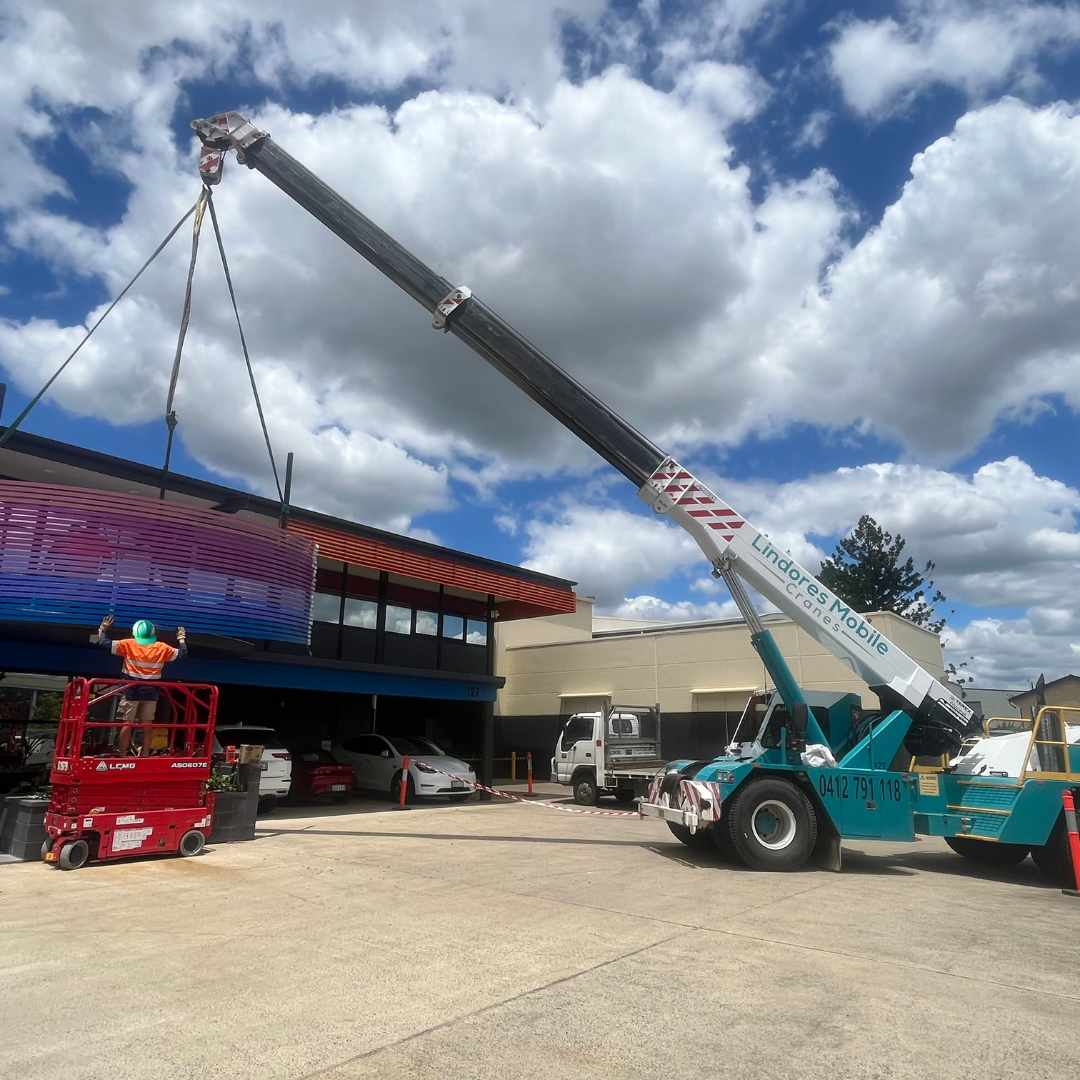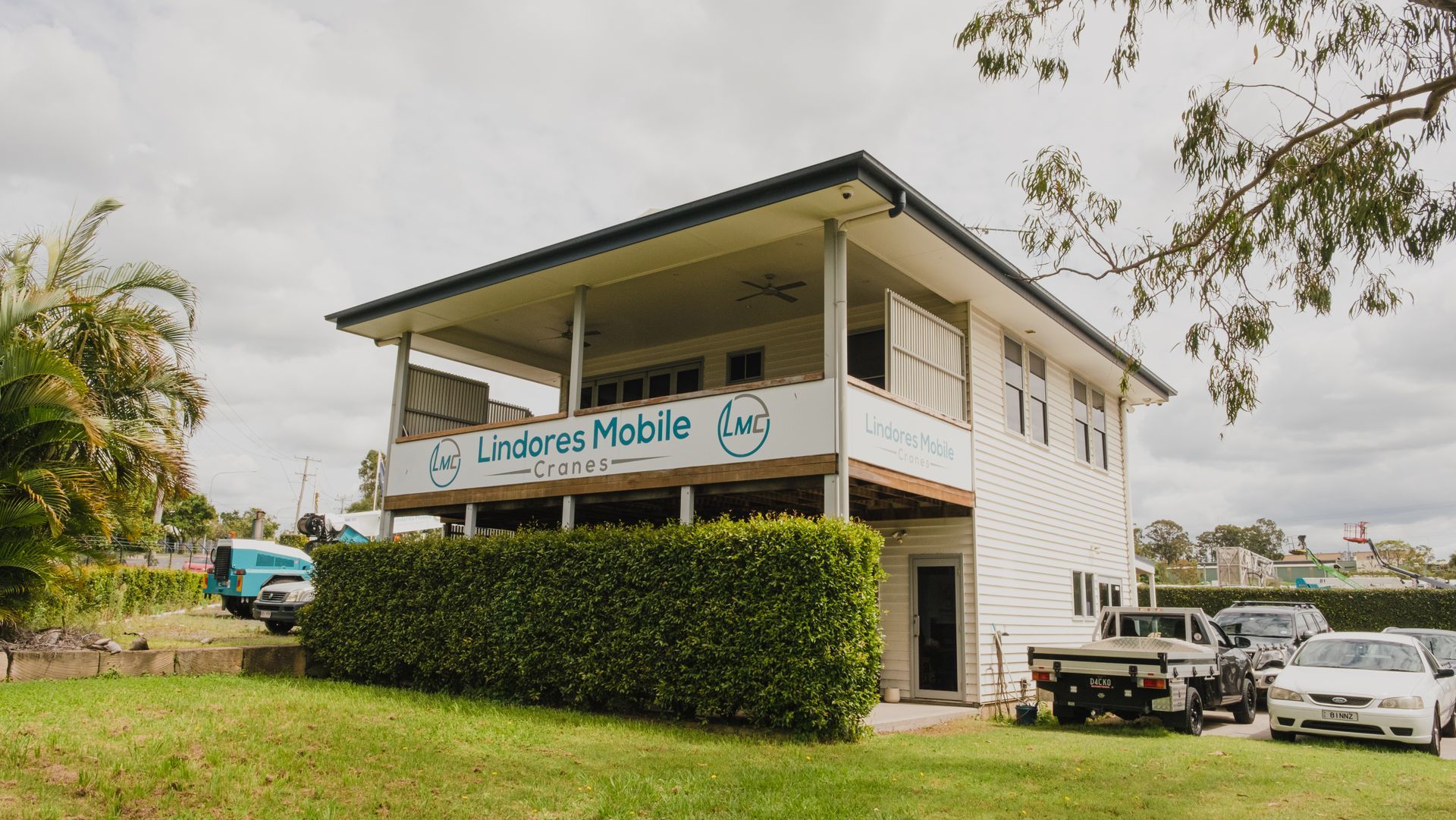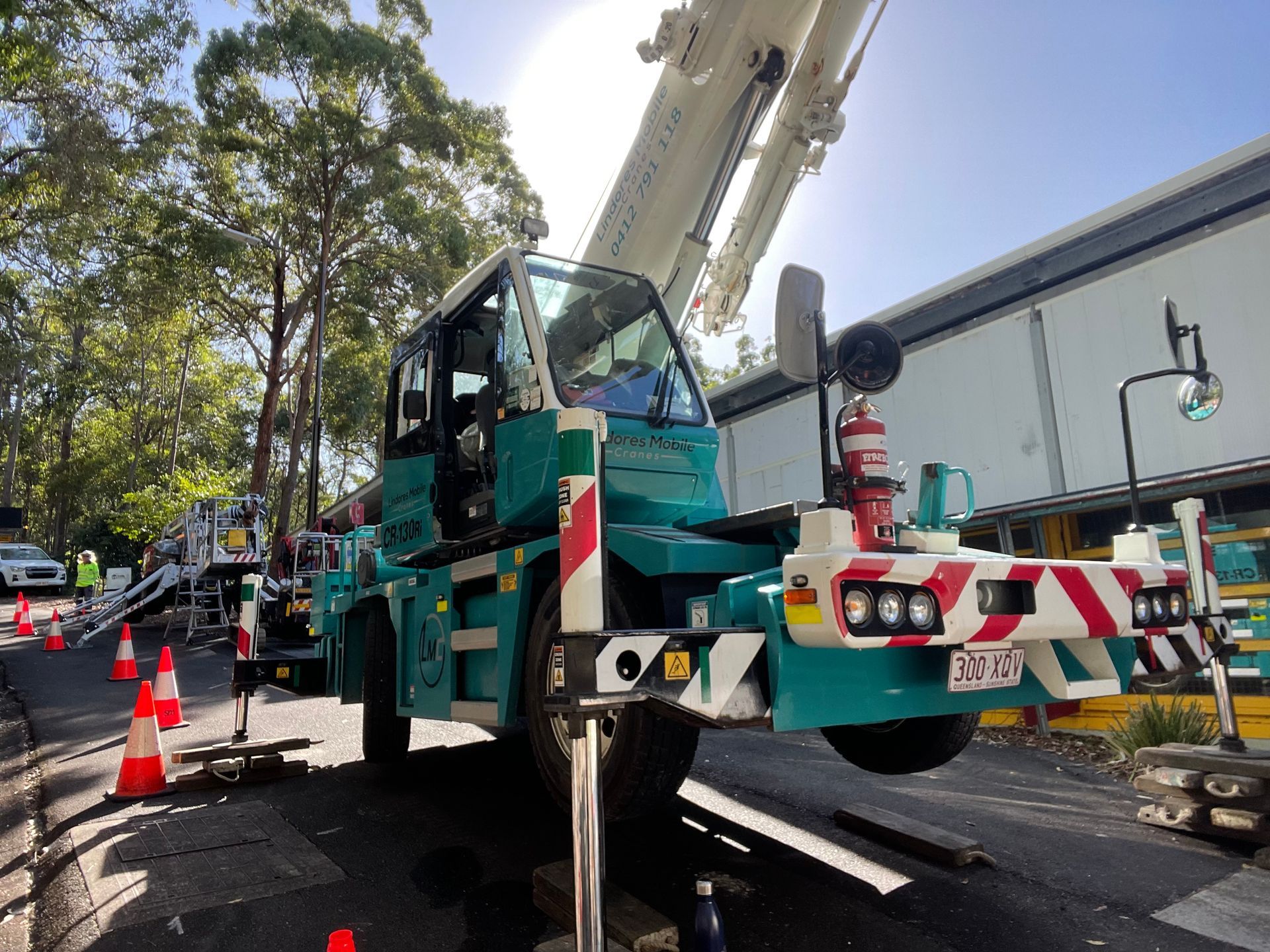Should I hire a mobile crane or a fixed crane
A mobile crane is a versatile and flexible option when it comes to crane hire, often rivalling a fixed tower crane for lift weight and height. When it comes to choosing which type of crane is the right choice for your project, it is important to consider what your project will require both in terms of lift capacity as well as timelines, site location and other project management constraints. In this article we will take a look at the difference between a fixed crane and a mobile crane and the benefits along with the disadvantages of each.
What is a mobile crane?
A mobile crane is a crane that is part of a vehicle and is able to be driven to the worksites. Mobile cranes come in lift capacities from 2 tonnes through to 500 tonnes. A mobile crane can be driven on ordinary roads as well as on difficult terrain such as sand and gravel.
What is a fixed crane?
A fixed crane, as the name suggests, is a crane that is fixed to the ground in a particular location to enable greater stability and lift capacity than a mobile crane. Fixed cranes include Bridge/Overhead Cranes, Bulk-handling Cranes, Hammerhead Cranes, Stacker Cranes and Tower Cranes.
The tower crane is the most commonly used crane for construction and is the crane most often being compared to a mobile crane for weight lift and efficiency.
Pros and Cons of a Tower Crane
Benefits of a tower crane
Disadvantages of a tower crane
Pros and Cons of a Mobil e Crane
Benefits of a mobile crane
Disadvantages of a mobile crane
Why choose Lindores Mobile Cranes?
Give the team at Lindores a call on 07 33760611 to talk cranes.
What is a mobile crane?
A mobile crane is a crane that is part of a vehicle and is able to be driven to the worksites. Mobile cranes come in lift capacities from 2 tonnes through to 500 tonnes. A mobile crane can be driven on ordinary roads as well as on difficult terrain such as sand and gravel.
What is a fixed crane?
A fixed crane, as the name suggests, is a crane that is fixed to the ground in a particular location to enable greater stability and lift capacity than a mobile crane. Fixed cranes include Bridge/Overhead Cranes, Bulk-handling Cranes, Hammerhead Cranes, Stacker Cranes and Tower Cranes.
The tower crane is the most commonly used crane for construction and is the crane most often being compared to a mobile crane for weight lift and efficiency.
Pros and Cons of a Tower Crane
Benefits of a tower crane
- Tower cranes can lift more than almost any other type of crane
- They are constructed on-site so they are stable and can be built to the height that is required for the build. This means that they are perfect for large scale developments such as high rises.
Disadvantages of a tower crane
- Tower cranes are extremely expensive to install
- Click To Paste
- Tower crane installation is complex and takes a significant amount of time
- Tower cranes have high maintenance costs
- Tower cranes can take up significant space within the worksite
Pros and Cons of a Mobil e Crane
Benefits of a mobile crane
- Mobility. A mobile crane can be moved to the exact location it is required on the worksite and when the lift is complete, the mobile crane can be removed, leaving the worksite free for other aspects of the project.
- Versatility. Mobile cranes versatility is what makes them so popular. They can even be used internally to complete fit-outs or to complete upper floors of multi-storey buildings.
- Quick Setup. Mobile cranes are able to be driven to the location, setup and after a safety check, are ready to be used. Their setup is quick and simple.
- Cost-Effective. The increased convenience of a mobile crane makes them a very cost-effective alternative to a fixed crane. The savings are not just in the hiring fee, which is much less, but also in the fact that you only hire a mobile crane on the days you need it for your project, instead of for the whole project.
Disadvantages of a mobile crane
- Less lift capacity. Mobile cranes can lift much heavier weights than most people first think, in fact, at Lindores we have access to mobile cranes that can lift up to 500 tonnes.
- Less height capacity. A mobile crane will be able to lift to a maximum height of 100 metres.
Why choose Lindores Mobile Cranes?
At Lindores Mobile Cranes, we have been in the crane industry for more than 40 years. Our company has pioneered mobile crane technology in Australia and have seen how mobile cranes can be used on virtually any project. We know our fleet; it’s capacity and its potential, and we are able to share the knowledge with you to ensure your project reaches new heights.
Give the team at Lindores a call on 07 33760611 to talk cranes.
The Liftout

At Lindores Mobile Cranes , we understand that the key to safe and efficient crane operations is regular preventive maintenance. By staying proactive, we minimise downtime, prevent costly repairs, and ensure our fleet remains in peak condition. Keeping our equipment in top-notch shape allows us to deliver the best possible service to you! Why is Preventive Maintenance Essential? Our cranes handle heavy loads daily and operate in demanding environments, which makes regular maintenance a top priority. Through routine inspections and servicing, we identify potential issues before they escalate, ensuring compliance with industry safety standards and extending the lifespan of our equipment. How Do We Maintain Our Cranes? Thorough Inspections We conduct daily and weekly checks on hydraulic systems, cables, brakes, and structural components to catch early signs of wear and tear. Lubrication and Fluid Monitoring Keeping our cranes properly lubricated and maintaining hydraulic and engine fluid levels helps us prevent mechanical failures. Routine Load Testing We regularly test our cranes to ensure they can safely handle the specified loads without risk of malfunction. Ongoing Operator Training Our experienced operators are trained to spot potential mechanical issues early, allowing us to address them before they cause disruptions. What are the Long-Term Benefits for Our Clients? ● Enhanced Safety – Our commitment to maintenance reduces the risk of accidents, protecting both our team and our clients. ● Operational Reliability – Well-maintained cranes mean fewer delays and smoother project execution. ● Cost-Effectivenes s – By preventing major breakdowns, we save on expensive emergency repairs and ensure competitive pricing for our services. Our Promise to You.. At Lindores Mobile Crane s, we take pride in maintaining a fleet that meets the highest standards of safety and efficiency. Our preventive maintenance program is more than just routine checks—it’s a commitment to delivering reliable, high-quality service every time you work with us. Why Choose Lindores Mobile Cranes ? When you partner with us, you’re choosing a team that values personalised service, unwavering dedication to safety, and a strong connection to the local community. As a family-owned business, we bring a level of care and expertise that sets us apart. Experience the difference our commitment makes— contact us today at lmcops@lmcranes.com.a u to learn more about our crane services.

At Lindores Mobile Cranes , cranes are in our DNA. We are a family-owned and operated company, dedicated to bringing you the best service. Our tight-knit team of skilled crane drivers, riggers and operations crew are passionate about delivering a personable experience that’s a cut above the rest. When selecting a crane service provider, opting for a family-owned and operated business like Lindores Mobile Cranes offers distinct advantages that can significantly enhance your project's success. In this blog, we outline some of the key benefits of working with a family-run company. Personalised Service Family-owned businesses often provide a level of personalised attention that larger corporations may lack. At Lindores Mobile Cranes , we take the time to understand each client's unique needs, ensuring tailored solutions that align with specific project requirements. Commitment to Quality and Safety With a family name associated with the business, there's an inherent commitment to maintaining high standards. We prioritise safety and quality in all operations, adhering to strict industry protocols to protect both our clients and team. Flexibility and Responsiveness Family-run operations can adapt quickly to changing project dynamics. Our team at Lindores Mobile Cranes is empowered to make swift decisions, allowing us to respond effectively to unforeseen challenges and keep your project on track. Deep Community Roots Being a family business, we have deep ties to the South East Queensland community. This local presence fosters trust and reliability, as we are invested in the success and development of our area. Long-Term Relationships We value building lasting relationships with our clients. Our family-oriented approach means we strive for repeat business and referrals, motivating us to exceed expectations consistently. Choosing Lindores Mobile Cranes means partnering with a team that offers personalised service, unwavering commitment to quality and safety, and a deep understanding of the local community. Experience the difference that a dedicated family-owned business can bring to your project. Enquire about our cranes today by contacting lmcops@lmcranes.com.au.

Operating mobile cranes is a critical part of many construction and industrial projects, but it comes with significant risks. Mistakes in crane operation can lead to project delays, equipment damage, or even serious injuries. At Lindores Mobile Cranes , safety and efficiency are at the core of what we do. Below, we’ll explore some of the most common mistakes in mobile crane operation and share how our team actively mitigates risks and prioritises safety on every lift. 1. Improper Site Inspection The Risk: Failure to assess the job site properly can result in uneven ground, insufficient clearance, or interference with nearby structures or power lines, all of which increase the risk of accidents. Our Solution: Lindores Mobile Cranes conducts thorough site inspections before every project. Our experienced team assesses the terrain, identifies potential hazards, and ensures the site meets all safety requirements. This proactive approach minimizes risks and ensures smooth operations from the outset. 2. Exceeding Load Capacities The Risk: Overloading a crane beyond its capacity can compromise stability, leading to equipment failure or tipping accidents. Our Solution: Our team rigorously calculates load weights and matches them with the crane’s capacity. We use advanced load-monitoring systems to double-check weight distributions in real-time. Additionally, our operators are fully trained to understand and adhere to each crane’s load chart. If necessary, we use multiple cranes to lift objects, ensuring sufficient lifting capacity and safe weight distribution. 3. Neglecting Proper Equipment Maintenance The Risk: Poorly maintained cranes are more prone to mechanical failures, which can cause downtime or dangerous malfunctions during operation. Our Solution: At Lindores Mobile Cranes , regular maintenance is non-negotiable. Our cranes undergo routine inspections and servicing by qualified technicians. We maintain detailed maintenance records and replace any worn parts before they become a problem, ensuring our equipment is always in peak condition. 4. Inadequate Operator Training The Risk: Untrained or under-qualified operators may misinterpret signals, improperly maneuver loads, or fail to respond correctly in high-pressure situations. Our Solution: We only employ certified and highly experienced operators. New employees receive consistent and thorough training and mentorship from senior members of our team, to ensure they uphold our high standard of service and operation. Additionally, our team is continuously trained and updated on the latest industry standards and safety protocols. 5. Ignoring Weather Conditions The Risk: Operating a crane in high winds, heavy rain, extreme temperatures or low-visibility heightens the risk of accidents, equipment damage and load instability. Our Solution: Weather conditions are always factored into our planning process. If conditions are deemed unsafe, we communicate transparently with our clients to reschedule operations. Our priority is always safety. 6. Failure to Use Proper Rigging The Risk: Improper rigging or using damaged lifting equipment can result in dropped loads, endangering workers and equipment. Our Solution: Our team is trained to select and inspect the right slings, shackles, and hardware for each lift. We follow strict rigging protocols to ensure every load is secure and balanced before lifting begins. 7. Poor Communication on Site The Risk: Miscommunication among team members can lead to errors in load handling, positioning, or crane operation, increasing the likelihood of accidents. Our Solution: We prioritise clear and consistent communication on all our job sites. Our operators, riggers, and ground crews use standardized hand signals and two-way radios to stay in constant contact, ensuring everyone is on the same page. Why Choose Lindores Mobile Cranes? At Lindores Mobile Cranes , we don’t just operate cranes – we deliver peace of mind. By prioritizing safety, meticulous planning, and industry-leading expertise, we ensure every lift is executed flawlessly. When you partner with us, you’re choosing a team committed to excellence, precision, and the highest safety standards. Ready to make your next project safer and more efficient? Contact Lindores Mobile Cranes today and experience the difference. For all enquiries, please contact lmcops@lmcranes.com.au.
